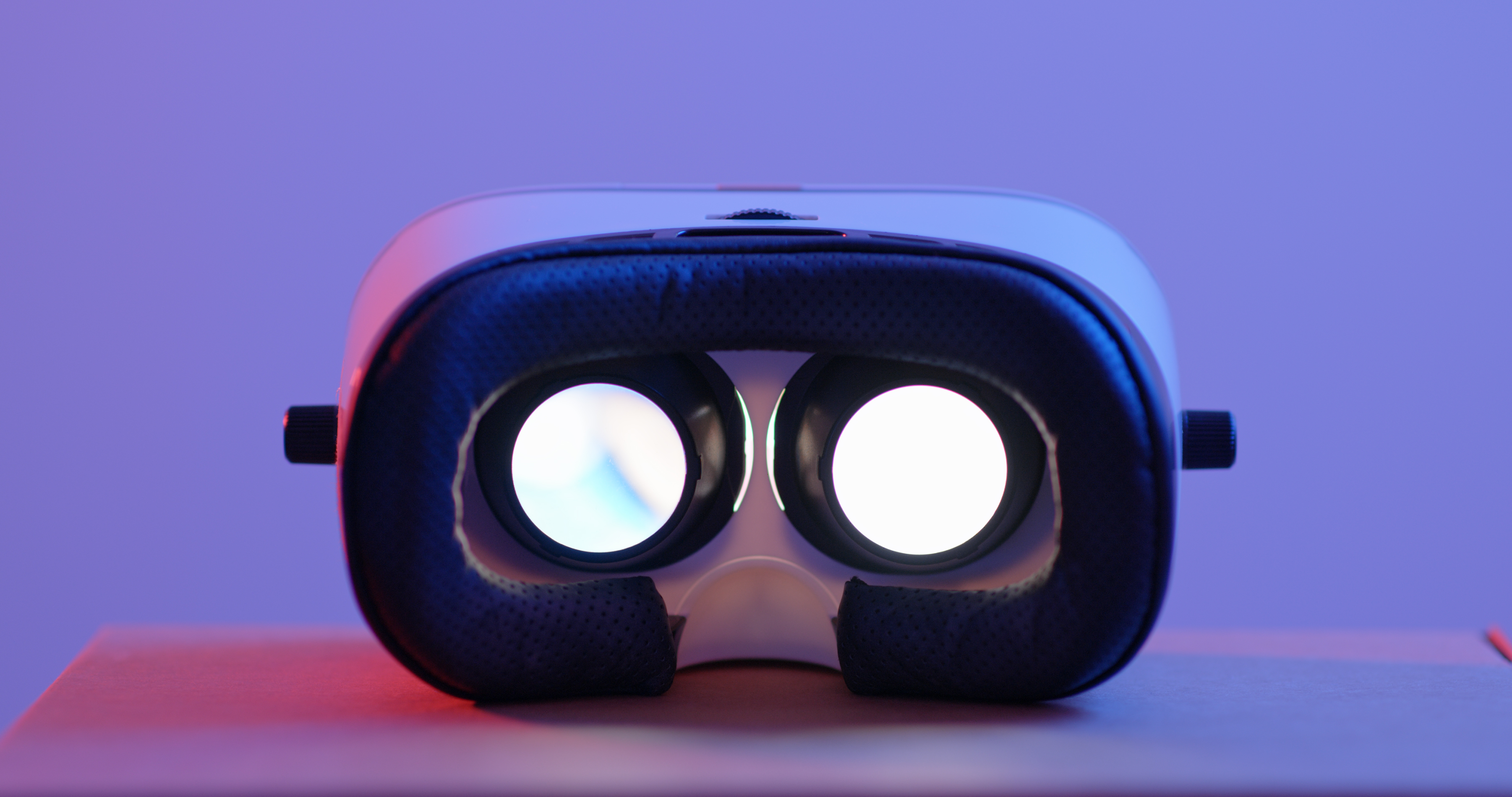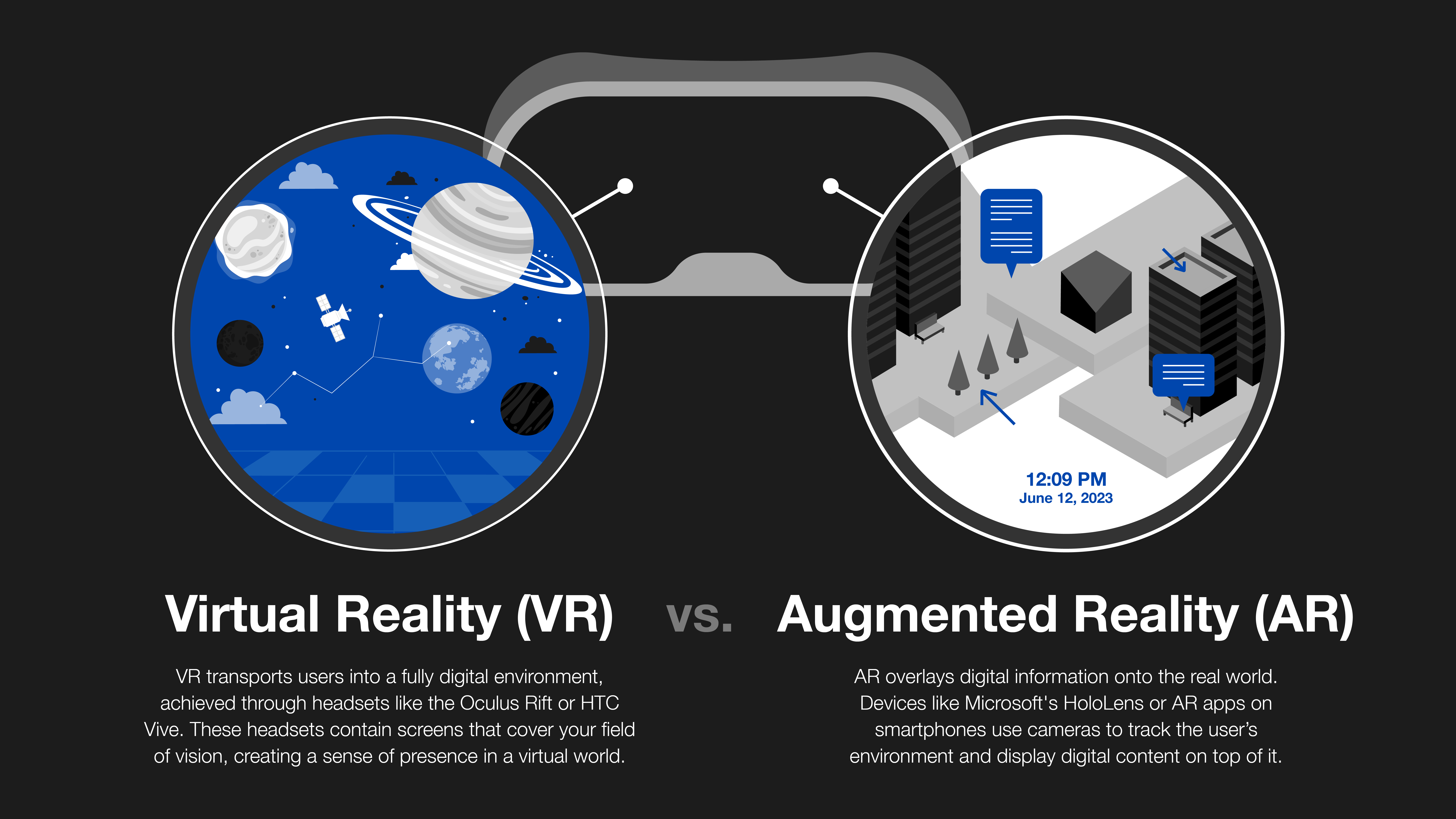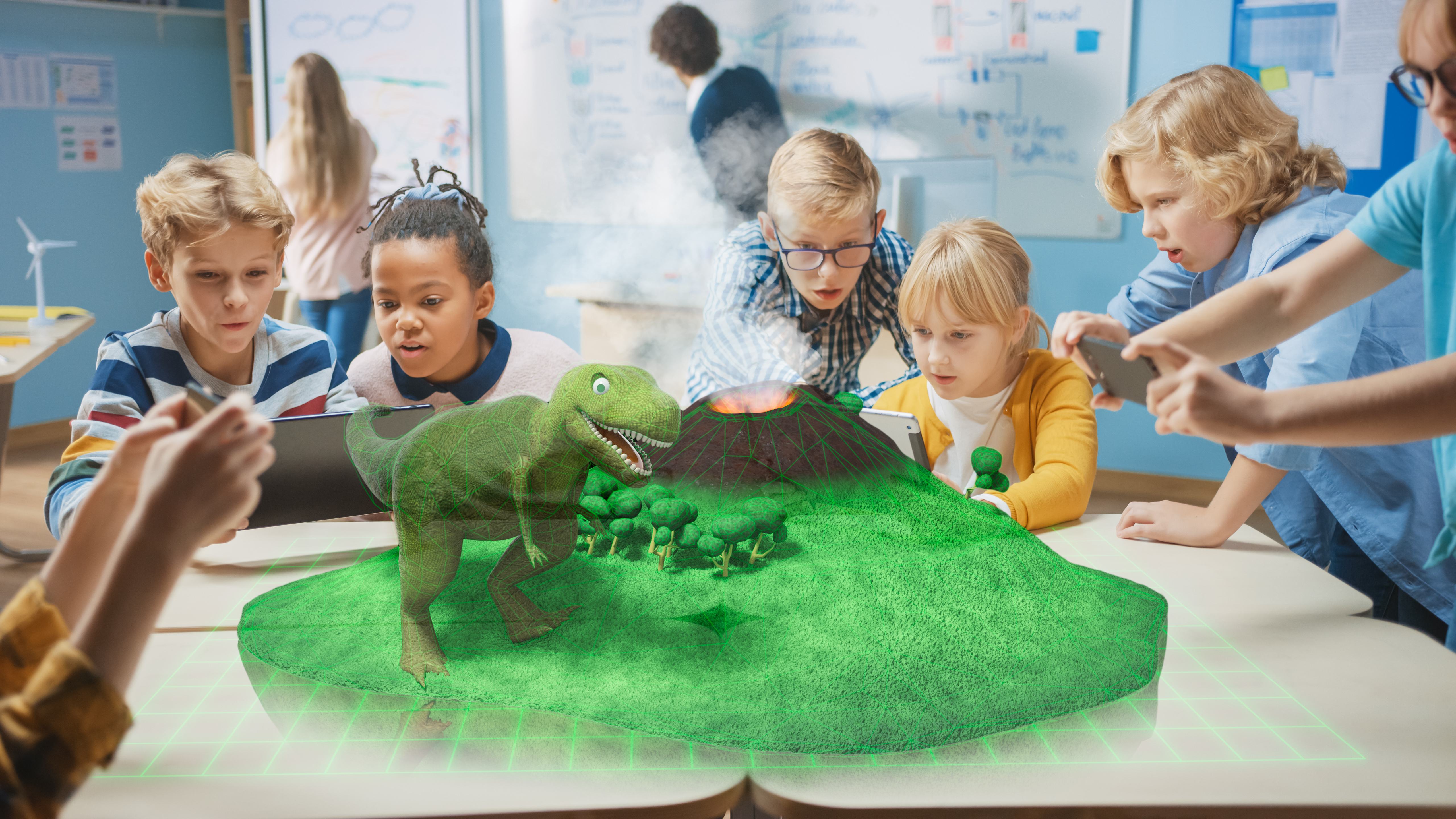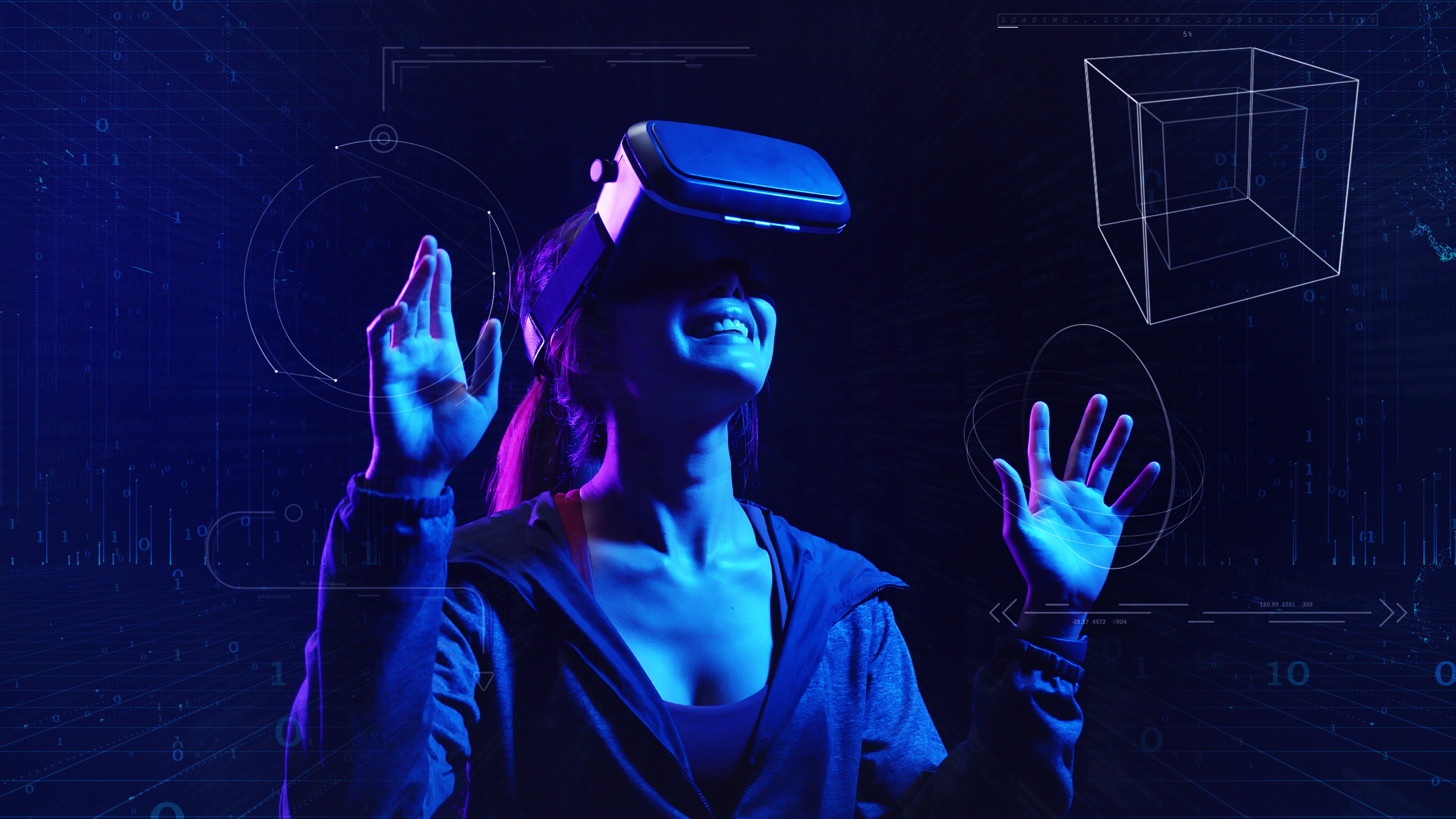Bridging the Past, Present, and Future of Tech
How VR and AR are Changing the Face of Entertainment and Beyond

We're entering an exciting era where virtual reality entertainment isn't just something we watch, but something we actively experience and become a part of.
Unveiling the Mechanics of Virtual Reality (VR) and Augmented Reality (AR)
As we embark on exploring the transformative impact of Virtual Reality (VR) and Augmented Reality (AR) in our lives, it's crucial to understand the intricate mechanics powering these groundbreaking technologies.
Virtual Reality (VR):
● Immersion through Headsets: VR transports users into a fully digital environment, achieved through headsets like the Oculus Rift or HTC Vive. These headsets contain screens that cover your field of vision, creating a sense of presence in a virtual world.
● Motion Tracking for Realism: VR headsets use various sensors and external cameras or lasers to track your head and hand movements. This allows the virtual environment to respond dynamically as you move.
● Audio-Visual Synchronization: High-resolution displays and spatial audio are key. The VR system synchronizes what you see and hear, adjusting as you navigate the virtual space. This synchronization is crucial for maintaining the illusion of reality.
● Haptic Feedback for Enhanced Experience: Advanced VR systems incorporate haptic feedback devices like gloves or suits, providing tactile sensations that mimic real-world interactions, like feeling the texture of objects or the impact of movements.
Augmented Reality (AR):
● Overlaying Digital Information: Unlike VR, AR overlays digital information onto the real world. Devices like Microsoft's HoloLens or AR apps on smartphones use cameras to track the user’s environment and display digital content on top of it.
● Spatial Awareness and Mapping: AR devices employ advanced algorithms for spatial awareness, understanding and mapping the physical space around the user. This allows digital content to be placed and anchored in the real world accurately.
● Interaction with the Physical World: AR technology recognizes physical objects and surfaces, enabling interactions between digital and physical elements. For instance, you can see a virtual sofa in your living room and walk around it, just as you would a real one.
● Seamless Integration and Accessibility: AR integrates smoothly with everyday life, as it often utilizes devices like smartphones or lightweight glasses. This ease of access and integration is a key factor in AR's growing popularity.
Understanding the basics of VR and AR allows us to envision how augmented reality will change entertainment, offering new dimensions to our experiences beyond traditional media.

Cutting-Edge Trends in VR and AR in Entertainment
A prime example of how AR or VR can be used for entertainment is seen in the advent of Mixed Reality (MR). This innovative technology blends elements of both AR and VR, creating a more fluid interaction between the real world and digital elements. MR facilitates applications that stretch from immersive gaming experiences, showcasing the entertainment potential of these technologies, to practical training simulations across various industries.

Influence of Virtual Reality on Diverse Sectors
The virtual reality entertainment industry has been pivotal in transforming how we consume media, bringing about a paradigm shift in everything from video games to cinema, live shows, and amusement park experiences. The question of how virtual reality changes entertainment has its answer in the profound changes we're witnessing across these areas.
Education
In the sphere of education, VR and augmented reality (AR) are breaking new ground. They act as conduits for experiential learning, taking students on virtual excursions to distant places and times. Research indicates that learning in a VR environment can lead to a 75% increase in retention rates compared to traditional methods. For example, how can VR be used in entertainment has been mirrored in education, as VR has enabled medical students to enhance their skills, showing improvements of more than twice the efficiency of conventional training approaches.
Examples in Education:
● Mondly: This language-learning platform leverages AR to create engaging scenarios for users to practice languages, placing them in real-world conversational settings.
● Anatomyou: An interactive VR journey inside the human body, giving medical students a unique perspective on human anatomy that can dramatically enhance their understanding and diagnostic skills.
Healthcare
Surgeons are now able to practice complex procedures via VR simulations, reducing the risks associated with surgery. AR glasses have made strides in the operating room by overlaying vital information like the patient's heartbeat, oxygen levels, and other critical data points onto the surgeon's field of vision. A study shows that AR can improve the surgical procedure's accuracy by 90%, indicating a seismic shift in operative care.
Examples in Healthcare:
● Virti: Utilizes VR for medical training, transporting medical professionals into high-pressure environments where they can practice their response to emergency situations without real-world consequences.
● AccuVein: Uses AR to map veins on the patient's skin, making venipuncture procedures much smoother.
Retail
Within the retail sector, the convergence of AR and VR technologies is revolutionizing the way consumers shop, blending the tactile allure of in-store browsing with the convenience of online shopping. AR grants shoppers the ability to visualize products in their actual environment, which can bolster consumer confidence by up to 90%, significantly reducing the hesitation that often accompanies online purchases. Meanwhile, VR introduces a dimension of virtual reality for entertainment to the shopping journey, crafting an engaging virtual storefront that can drive sales conversions upward by an impressive 17%.
Examples in Retail:
● IKEA Place: Lets users visualize furniture in their home.
● Sephora Virtual Artist: Allows customers to try makeup on virtually using their smartphone.
Journalism and Media Dissemination
Journalism and media are tapping into augmented reality entertainment industry technologies to convey stories in a more engaging and immersive manner. News outlets are employing VR to place viewers right in the middle of the story, creating a more profound connection and understanding of the events. AR brings static articles to life by providing interactive elements such as animated infographics that pop up from the newspaper's page.
Examples in Media:
● The New York Times VR: Transports readers to the center of news stories through immersive journalism.
● Reuters: Uses AR graphics in news broadcasts to illustrate complex stories visually.
Manufacturing
In manufacturing, AR and VR are ushering in a new era of precision and efficiency. Ford, for example, uses VR in their design process, allowing engineers to work on virtual models of vehicles, tweaking designs in real-time without the need for costly physical prototypes. AR is also assisting workers on the factory floor with complex assembly processes by projecting instructions directly into their line of sight, reportedly reducing errors by up to 90%.
Examples in Manufacturing:
● Boeing: Employs AR glasses to display real-time information, helping technicians wire aircrafts more accurately.
● Ford: Utilizes VR for vehicle design and testing, streamlining the development process.
Marketing & Advertising
In the dynamic sphere of marketing and advertising, the incorporation of AR VR in media and entertainment is reshaping how brands interact with consumers. These advanced technologies are not just novel gadgets but are pivotal in forging memorable experiences that significantly elevate consumer interaction and fortify brand recognition. For instance, automotive manufacturers are now offering virtual reality showrooms, enabling potential buyers to customize and explore vehicles in a fully immersive setting, a move that has seen customer engagement times quadruple.
Examples in Marketing & Advertising:
● Nike's Virtual Sneaker Try-On: Nike’s AR toolkit in their app allows customers to see how sneakers would look on their feet in real-time.
● Gucci's AR Wardrobe: Gucci's mobile app uses AR for users to try on watches and shoes, enhancing the online shopping experience.
The diverse deployment of AR and VR technologies illustrates their capability to craft captivating stories and interactive marketing ventures. Embracing these innovations allows companies to transcend beyond mere novelty, offering tangible benefits that redefine the interaction paradigm between media, entertainment, and the end consumer.

AR and VR: Redefining the Entertainment Sector
This seamless integration of augmented reality in the entertainment industry, along with virtual reality, is crafting captivating experiences that were once relegated to the realms of fantasy. Notably, with the advent of AR, live performances and exhibitions are now morphing into interactive odysseys that resonate on a personal level, forever altering the spectator's journey from passive viewing to active engagement.
Gaming
Augmented reality in gaming and entertainment is reshaping player experiences, turning static gameplay into interactive journeys. Virtual reality titles such as 'Sword Rhythm' and 'Portal Runner' redefine the gaming paradigm, offering comprehensive, sensory-rich experiences that elicit profound emotional responses and a surge of excitement among participants.
Concerts and Live Events
The concert and live event spaces showcase how VR is used in entertainment, offering virtual attendance options that provide every viewer with a VIP perspective, unhindered by physical venue limitations.
Film and Television
Within cinema and television, questions around how is virtual reality used for cinema and entertainment are addressed by VR's ability to immerse viewers directly into the story, offering a novel narrative dimension. The impact of VR on filmmaking — how has virtual reality affected the film industry — is observed in its ability to expand the scope of cinematic expression.
Theme Parks and Attractions
Theme parks have embraced VR to amplify thrills, combining the rush of roller coasters with the fantasy elements of virtual realms to deliver unparalleled experiences. "The VOID" exemplifies this with its hyper-reality attractions. Meanwhile, AR enhances even the queuing experience, turning the wait into an interactive prelude to the adventure. A prime example is Disney's "Star Wars: Galaxy’s Edge," which, through an app, converts the park into an expansive live-action game. The niche market of AR for theme parks is booming, expected to reach a value of $3.2 billion by 2027, highlighting the significant role of AR and VR in redefining amusement experiences.
The story of VR and AR is just beginning. As these technologies continue to evolve, they are set to permeate every facet of our lives, especially in entertainment. The future holds a thrilling journey, promising an exhilarating blend of reality and virtuality that will redefine our leisure and engagement with media.
In this evolving landscape, we at TDK are contributing alongside many, playing our part in the evolution of VR and AR technologies. Our developments in critical components such as haptic feedback devices, motion sensors, and microphones are our additions to this field. These components are essential in enhancing the sensory experience, making virtual environments more realistic and immersive.
TDK is a comprehensive electronic components manufacturer leading the world in magnetic technology





